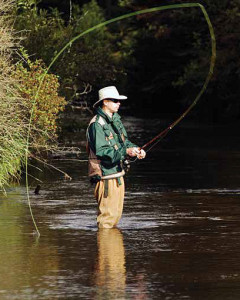Two out of every three raindrops that fall in Georgia land on the lush canopy of trees that blanket the state. Under that canopy, we breath in the great outdoors while hiking, fishing, birdwatching and more. Beyond their beauty, those trees are hard at work for Georgia. They give us clean water, clean air and a prosperous economy. Working together, we all can ensure that they – and we – continue to thrive.
Executive Summary
Georgia is an ideal place to live and work – offering a quality of life that is unmatched. We are business friendly, benefit from a temperate climate and boast world class recreational and cultural experiences. Key to this way of life is the state’s robust forest industry, which supports our economy, natural resources and recreational opportunities.
In addition to filtering our water and cleaning our air, Georgia’s 24 million acres of forests support 148,414 jobs and provide $36.3 billion in economic value. Both the vast acres of forest that span rural Georgia and trees that shade our suburban parks and line our city streets require careful management and investment.
Georgia has more acres of privately owned timberland than any other state in the nation, but many Georgians don’t see working forests in their daily lives. So, the environmental and economic importance to our state may not be obvious. Working forests are like tree farms. These trees are planted for harvest and replanted like other crops. Along the way, those trees produce clean air and clean water, capture carbon and provide jobs—lots and lots of jobs.
Most of the trees covering our state are, in fact, planted, harvested and replanted on farms owned by private landowners. So, like any other crop, it is important for the people who plant those trees to have markets to sell them when they are harvested. From paper and houses to furniture, many of the products you use come from trees.
The whole cycle—from planting and harvesting through use and replanting— is remarkable. It is also fragile. As our state urbanizes and suburbanizes, there is more pressure to develop land. We have a vested interest in ensuring that public policy and healthy markets support the growth and regrowth of trees across Georgia’s countryside, suburban landscapes and in our cities.
Forests for Georgia’s Economy
Georgia’s population is increasing at record rates. Within 25 years, the number of people calling our state “home” is expected to jump from 10 million to almost 15 million. As we monitor the impacts of that growth, it is prudent to pay special attention to its effect on vital natural resources, including the state’s water, air and wildlife. The one critical link that impacts the health of each of these resources is Georgia’s 24.6 million acres of forest land. —Georgia’s Sustainable Forests: A Resource for All Generations
ECONOMIC IMPACT
 As the top forestry state in the nation, Georgia’s trees are an economic powerhouse. The industry generated more than $36 billion and supported more than 148,000 jobs throughout the economy in 2018. That’s more than both the film and automotive industries in the state.
As the top forestry state in the nation, Georgia’s trees are an economic powerhouse. The industry generated more than $36 billion and supported more than 148,000 jobs throughout the economy in 2018. That’s more than both the film and automotive industries in the state.
Georgia is home to the world’s largest wood rosin plant, the world’s largest wood pellet plant, the world’s largest crude tall oil bio-refinery and North America’s largest recycled paper mill.
Working forests impact communities across the state, with 83 of Georgia’s 159 counties boasting at least one primary wood-using mill. Nearly 200 mills across the state produce primary wood products such as lumber, veneer, poles and posts along with wood pulp and wood pellets, which are used to produce energy. More than 1,000 secondary mills further process the primary products into furniture, paper products, cabinetry and more.
According to a recent Georgia Tech study, industry job growth has been increasing for the past seven years – directly supporting 55,089 forestry jobs with compensation totaling 4.0 billion. Pulp and paper products are the largest segment of the industry, with 61 percent of revenue and 36 percent of jobs in 2018.
The industry also provided a significant contribution to the state tax base, with $977 million in gross tax revenue. Georgia’s urban and community forestry companies generated an additional $4 billion of economic activity in 2017.
Strong markets for forest products are crucial to the future of traditional pulp and paper, lumber and pole supplies.
RECREATION
 Deeply inhale the crisp air. Hear the gurgle of a stream or the chirp of the brown thrasher, Georgia’s state bird. Head out for a strenuous five-mile hike on a wooded path. Forests provide the ultimate green space for thousands of Georgians and out-of-state visitors who enjoy our forests every year.
Deeply inhale the crisp air. Hear the gurgle of a stream or the chirp of the brown thrasher, Georgia’s state bird. Head out for a strenuous five-mile hike on a wooded path. Forests provide the ultimate green space for thousands of Georgians and out-of-state visitors who enjoy our forests every year.
The world-renowned Appalachian Trail, or AT, begins at Georgia’s Springer Mountain. Dozens of lakes across Georgia provide expansive beauty and respite along with swimming and boating. Georgia offers anglers a wide variety of opportunities, from trout streams to bass fishing. From city parks to mountain trails, Georgia’s trees provide extensive and varied opportunities for outdoor activity while supporting healthy people and healthy communities across the state. Forests contribute to a high quality of life for all those who call Georgia home and the millions who visit the state each year.
Outdoor recreation is also big business in the state. About 400,000 Georgians hunt and more than twice as many fish, bringing in $5.5 billion and supporting 40,000 jobs.
Forests for Georgia’s Environment
SUPPORTING OUR ECOSYSTEM
Just beneath the surface of a serene and peaceful forest there is a tremendous amount of hard work happening quietly and mostly unnoticed. Without fanfare, forests keep our air clean. They filter our water. They absorb carbon dioxide. They help control erosion. And they offer habitats for wildlife.
The University of Georgia estimates that forests provide $37.6 billion worth of environmental services for Georgians, cleaning our air and water each year. That value comes from water quality, carbon sequestration and wildlife habitat.
Carbon sequestration takes place when trees absorb carbon dioxide from the atmosphere, storing it in their branches, trunks, roots, leaves and in the soil of forest floors when trees die and decay. This process can help combat climate change. Georgia’s forests sequester between one and four tons of carbon per acre each year, offsetting approximately eight percent of the state’s emissions.
Georgia’s Carbon Sequestration Registry, established in 2004, enables forest owners to voluntarily report projects that promote sequestration. The registry helps raise the profile of projects and participants. To make an increased impact, the state could pass a greenhouse gas policy that includes forest-based offset projects. When forest owners have the opportunity to benefit from the ecosystem services provided by their property, they are less likely to convert the land for other uses that may offer greater financial incentives.
Many of the thousands of Georgia’s streams flow through forestlands. These forest streams filter and purify water for millions of Georgians. Water produced by these forest streams is much less expensive to treat at municipal treatment plants than streams flowing from land used for other purposes. The estimated 7,000 forestry operations conducted on some 800,000+ acres per year statewide highlight the importance of following Best Management Practices (BMPs) to protect these water resources.
It is important for all Georgians to protect and support the ecosystems that support and protect us.
HEALTHY HABITATS
From deer and foxes to toads and hawks, Georgia’s forests are home to thousands of wildlife species – including many that are at risk for extinction. In fact, Georgia ranks eighth among states for the number of species that are at risk and fifth in the number of extinctions. Experts have identified nearly 300 animal species and nearly 325 plant species that need protection.
Forestry management tools for wildlife and ecosystem conservation include prescribed fire plans, minimizing the loss of forest lands and management of invasive and alien species. Fires are both natural and necessary for long term sustainability and ecosystem health. Planned fires are an important tool to support that health while minimizing damage.
The sustainability of Georgia’s wildlife, particularly the endangered species, depends on public and private conservation lands and public policies that support forest protection and professional management.
Georgia’s Policies for our Forests
Government policies have a big impact on the forest industry. Policies should support the long term well being of this industry that provides so many economic and environmental benefits across the state.
VALUATIONS AND TAX STRUCTURE
Property tax policies for forest lands have a significant impact on decision making by owners. Two Georgia laws provide tax benefits for forest conservation: Conservation Use Valuation Assessment in 1991 (CUVA) and the Forest Land Protection Act in 2008 (FLPA). Each of these laws provide for ad valorem tax exemptions for forestland that will be preserved as such for a decade or 15 years respectively. Nearly half of Georgia land (47 percent) was enrolled in these programs from 2009-2012.
In 2018, Georgia voters approved “Amendment 3” to the state constitution to make the valuation of forest lands more uniform across the state. It will continue to be important that counties across Georgia administer the valuation and tax laws consistently. Fair valuations, consistency across the state and conservation incentives will help ensure that Georgia continues to benefit from the ecosystem services and the jobs and industry that support our economy.
TIMBER SECURITY
Supporting forest landowners by providing protection from timber theft is important for ensuring the long-term sustainability of Georgia’s forests. Since 2014, Georgia’s timber security has been more rigorous with the passage of House Bill 790. The Georgia Forestry Commission (GFC) is responsible for enforcing timber security in the state. Since 2014, GFC has investigated 483 complaints resulting in $413,434 of recovered damages to date (with many additional complaints pending judgment).
NATURAL DISASTER RESPONSE
Forestlands are continually at risk for damage due to natural disasters. Most recently, more than two million acres of Georgia forests were impacted by Hurricane Michael in October 2018. The value of this damage was estimated at $762,683,909 and meant generational losses for many of the state’s private landowners.
Georgia’s state leadership responded by passing emergency legislation (HB 1EX and HB 1 4EX) that provided $270 million for relief. The funds were directed to a tax relief program for forest landowners as well as cleanup efforts and heavy firefighting equipment. Landowners are required to reforest their land in order to be eligible for the tax relief program. This kind of swift action in support of the forestry community will continue to be important in coming years.
